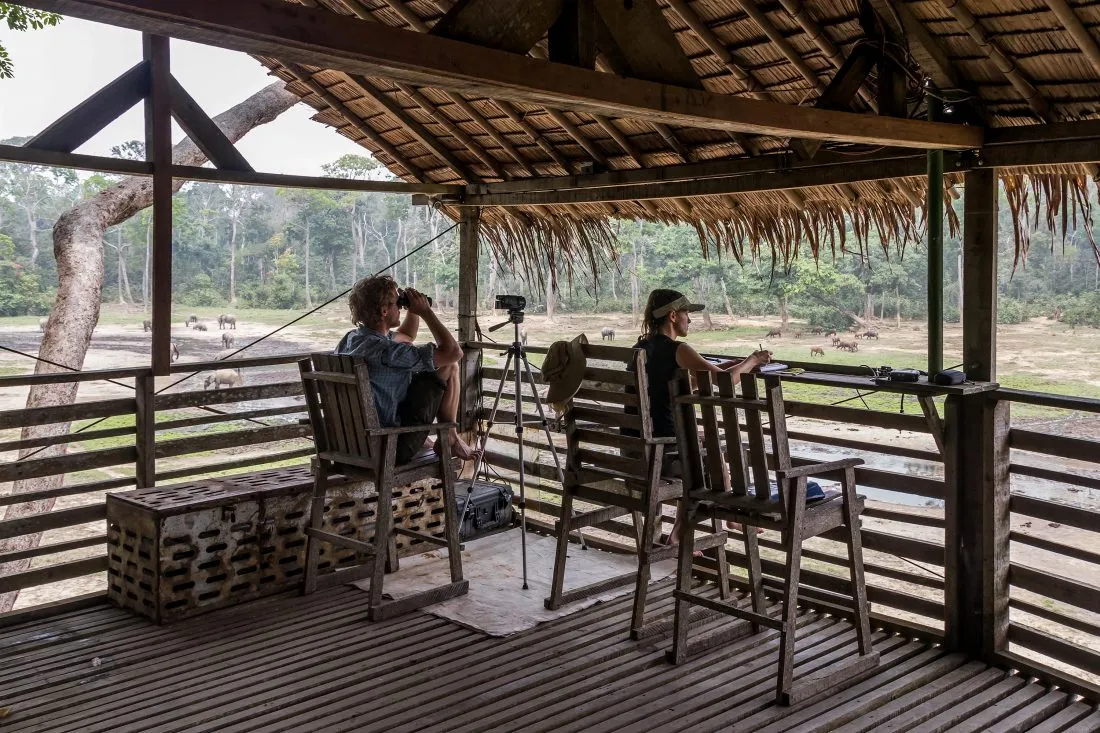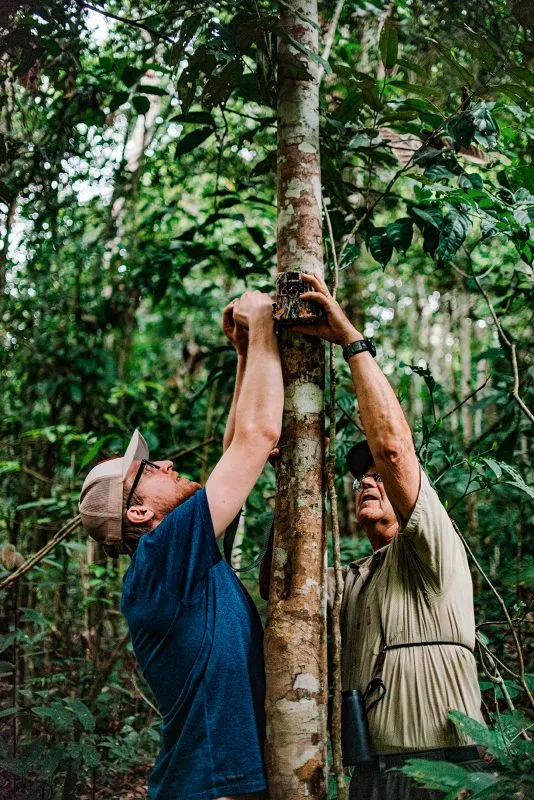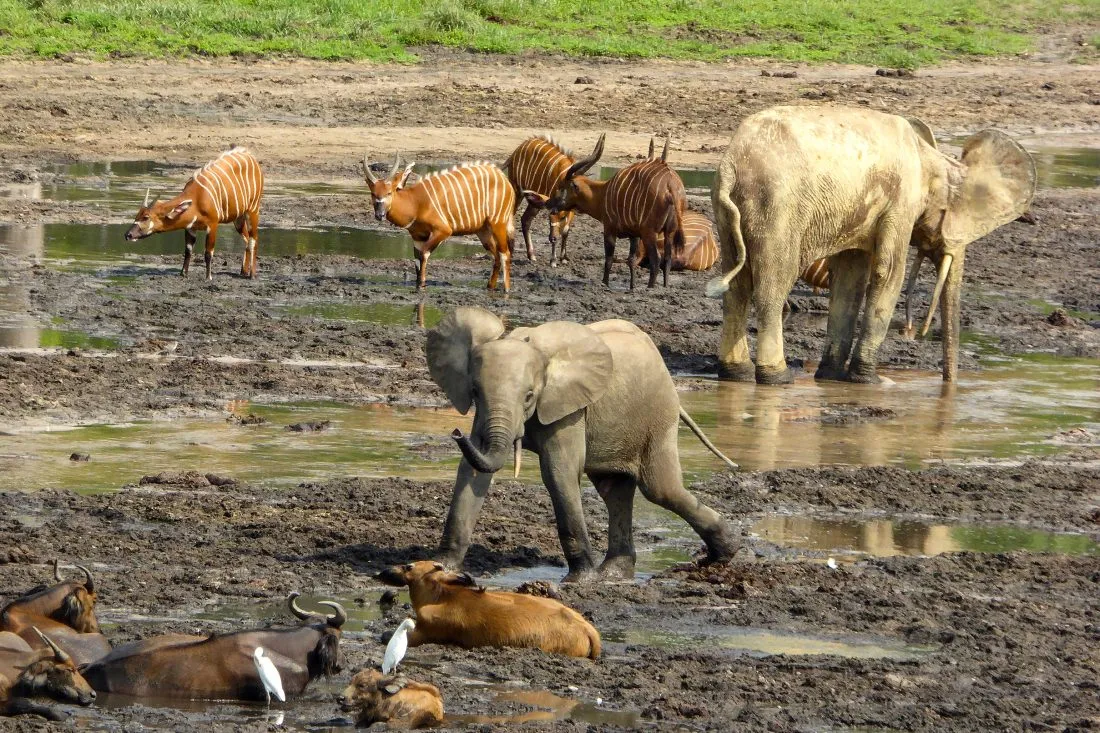
Ph.D. candidate Colin Swider overlooking Dzanga Bai, a mineral-rich clearing where African forest elephants congregate.
If you were to take a low-flying plane over the rainforest in Central Africa, you’d be struck by how dense the canopy appears, stretching to the horizon like a carpet, broken only by looping ribbons of river. At ground level the forest is often as impenetrable as it looks from above, but there are occasional natural clearings. One such clearing is in the Dzanga-Ndoki National Park in the Central African Republic, where animals congregate for the concentrated deposits of minerals in streambeds. For decades, researchers from around the world have made their way to this remote spot, called Dzanga Bai, where they are able to observe forest-dwelling species that are otherwise rarely seen.
Colin Swider, a Ph.D. student in Professor Susan Parks’ Bioacoustics and Behavioral Ecology Lab in the College of Arts and Science , has made two trips to Dzanga Bai. While many of his colleagues in the lab study marine mammals, Swider has focused on African forest elephants. Forest elephants are evolutionarily distinct from those that live in the savannah, and they have remained largely mysterious to the scientific community. They are a social species, communicating with complex and varied vocalizations. “I believe acoustic research is the most promising method we have to help us understand this elusive species,” Swider says. “Microphones distributed across large areas of the forest allow us to detect their vocalizations and gather data that would be otherwise very difficult to come by.”
At Dzanga Bai, Swider lives for months at a time at a small research camp and spends hours each day watching elephants as they move around the clearing, socializing and interacting with one another. He is working with colleagues from the Elephant Listening Project , a program of the Center for Conservation Bioacoustics at the Cornell Lab of Ornithology , to map elephants’ vocalizations to characteristics like age, sex, social status and mood. A more nuanced understanding of their communication will allow scientists to analyze acoustic data gathered from the widely distributed microphones in greater depth and glean insights about the makeup of social groups and, to some degree, what the elephants are saying to one other.
From Moral Imperative to Practical Application

Swider and Peter Wrege, director of Cornell University’s Elephant Listening Project, secure a trail camera.
In addition to elephant vocalizations, the microphones also pick up sounds of human activity, including gunshots. Despite a long-standing international ban on ivory trade, elephants are still hunted by poachers, and their tusks, meat and other body parts are sold illegally around the world. What drives the research Swider and other scientists are doing is the hope that a better understanding of forest elephants will lead to their better protection. “The data we gather helps predict where and when poaching is most likely to occur and also helps us track patterns in elephant response to human activity,” Swider explains. “This information allows conservation initiatives to combat poaching more effectively and efficiently.”
Swider lives without electricity, internet or running water at Dzanga Bai, and aside from the one or two other researchers who may also be there with him, his only regular contact with people is on the trips he makes every couple of weeks to get supplies at a small village about 10 miles away. It’s an existence Swider adjusts to quickly, he says, and finds peaceful and enjoyable. During his time in Central Africa he’s had many breathtaking experiences, including night kayaking under a sky thick with stars, and encountering lowland gorillas while out on a walk. But one of the most powerful experiences Swider had was deeply unsettling, and it drove home the ultimate purpose of his graduate work.
The data we gather helps predict where and when poaching is most likely to occur and also helps us track patterns in elephant response to human activity.
Colin Swider
One evening, the usual music of night insects was shattered by a nearby shot. Swider recognized the sound of a large rifle, the sort used to kill elephants. Shortly after that, a sputtering of gunfire erupted—a firefight between park rangers and poachers. Swider and two colleagues who were also at Dzanga Bai sprang into action, stumbling through the dark to the nearby encampment of rangers. By the time they arrived, two of four poachers had been apprehended and the rangers had confiscated the ivory, freshly cut from an elephant.

A young African forest elephant interacts with forest buffalo while bongo antelope look on.
That night was the first time Swider put a face to the concept of a poacher. The next day, he visited the elephant remains. He wrote about the experience in his journal:
Before, poaching was to me something that took place somewhere far off in the jungle, the effect of which we see only indirectly through diminishing wildlife populations. Now, it was in my backyard. I heard the shot. I smelled the sickening odor of the carcass. I touched the elephant’s thick skin and ran my fingers over the long, tough hairs. Poaching is no longer some abstract concept to me. When I felt the weight of the ivory in my hands—saw the dirt and blood—it hit home. This is what my dissertation is really all about.
Colin Swider
A Unique Opportunity to Connect with Leading Scholars
Being part of Parks’ lab has allowed Swider to work with an international network of scholars and scientists. It was this access to a wide range of resources that attracted him to Syracuse University for doctoral studies.
Swider earned an undergraduate degree in environmental biology from the State University of New York College of Environmental Science and Forestry in 2012. Afterward, he conducted research in Canada studying acoustic communication in birds and the impacts of anthropogenic noise on their behavior. As he looked for a way to expand his studies to elephants, which fascinated him because of the sophistication of their communication, Syracuse University provided a unique value. “Because of Professor Parks’ connection to the Center for Conservation Bioacoustics at Cornell, I’ve been able to take advantage of the support, connections and research avenues from both universities,” he explains. When he was offered a National Defense Science and Engineering Graduate Fellowship , as well as a Syracuse University graduate fellowship, Syracuse was the obvious choice.
Swider’s commitment to his research has led him to study a diversity of topics, ranging from the physics of sound (how it is produced by certain animals, for example, and how it propagates through various environments) to forest ecology and conservation. Because elephants are keystone species, meaning their activities disproportionately shape the ecosystems in which they live, their protection is an essential component of conserving the rainforest of the Congo Basin. “Fruit is elephants’ preferred food source, and many tree species depend specifically on elephants for seed dispersal,” Swider says. “Forest elephants maintain the structure of the plant communities in the areas in which they live. Without elephants, our forests could lose a lot of diversity.”
When Swider imagines the career he is preparing for, he is excited about the possibilities of acoustic monitoring in diverse contexts. “These techniques are applicable in a wide range of inhospitable, remote areas and could really open up to scientific inquiry a plethora of data that are otherwise out of our reach,” he says. But the elephants have made an indelible impression; Swider knows he will keep studying them throughout his career. And although the global COVID-19 pandemic cut short Swider’s most recent visit to Africa, the powerful experiences he had there sustain him as he works to complete his dissertation. The goal is clear: He is working for a future when, for decades to come, people will climb onto the platform at the edge of Dzanga Bai, train their binoculars on the marshy opening, and be able to watch majestic elephants living in peace in their forest home.

